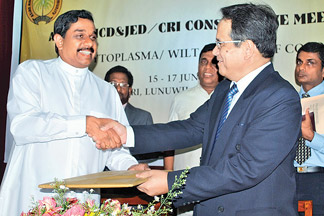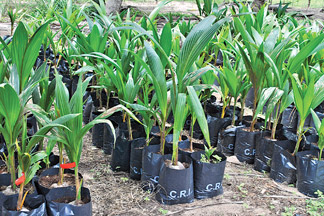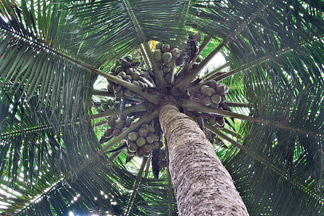Where have all the coconuts gone?
By Shirajiv SIRIMANE
|

Minister Pushpakumara presenting a token to Aron
|
History states that the first coconut tree was planted in Weligama
and it's also ironic that a incurable Coconut wilt disease has come to
light in this same area, threatening the existence of coconut plants in
the area.
Minister of Coconut Development and Janata Estate Development, Jagath
Pushpakumara said that this is something like AIDS or cancer for which
there is no cure. "The only option is to fell the trees and destroy the
leaves and other living organisms in the tree so that it won't spread to
other areas," he said.
The Minister said that due to timely measures taken by the government
they have been able to contain the spread of the disease outside the
Southern Province.
He said that a three kilometre wide 88 kilometre length buffer zone
has been put into place starting from Galle to Akuressa in a bid to hold
the spread of the disease.
He also said that they are paying compensation for each tree that is
being cut and are providing alternative measures so that people could
earn a living. "We are trying to introduce cash crops and animal
husbandry so that the people could earn a livelihood because of the loss
in coconut cultivation.
"There are about seven hundred thousand smallholdings accounting for
three hundred and twenty three thousand hectares. The average annual
production of coconut is about two thousand nine hundred million nuts.
|

A hybrid nursery in Lunuwila
Pix: by Ranjith Asanka |
However, due to adverse weather conditions which prevailed in the
year 2009, the annual production of coconuts was reduced to around two
thousand, three hundred and sixteen million in 2010", the Minister said.
"Out of this a total of about two thousand million nuts are locally
consumed. The per capita consumption of coconut is 109 nuts and this
amounts to about 70 percent of the total production. Thus, only 584
million nuts are available for making other economic products such as
coconut oil, desiccated coconut and other kernel products in 2010.
"My Ministry is currently implementing several programs to increase
production to 3,500 million nuts in the next five years and up to 4,000
million nuts by 2020 to meet the total demand of the domestic and export
sectors."
It is also planned to produce 28 million certified seedlings and
distribute them among growers in the next few years to expand area of
cultivation. To meet this challenge the performance of both smallholder
and estate sectors have to be improved.
"Productivity of smallholdings is generally low compared to the
estates.
|
Coconut fact file
 |
|
Sri Lanka is
the world’s fourth highest coconut producer with over 394,000
hectares being cultivated.
(Indonesia, Philippines and India are ahead of Sri Lanka, while
Thailand is in fifth place.)
Sri Lanka and Thailand account to 95% of the world’s fresh
coconut export market.
Sri Lanka is the world’s second largest desiccated coconut
exporter after Indonesia.
Sri Lanka’s coconut harvest is low since only around 8 to 10
percent use fertiliser.
To overcome this, under the ‘Mahinda Chintana’ the government
invests Rs. 2,300 million annually for coconut fertilizer
subsidy.
Weligama coconut plight was first spotted in 2007 and todate
38,200 acres (45,000 owners) are being affected, between Galle
to Tangalle. |
This is because smallholders are unable to manage their plantations
due to financial difficulties. Most of them are also not full time
dependents on coconuts for their livelihoods.
"Due to this and many other reasons, coconut productivity has
declined over the years.
The soil has been subjected to erosion and degradation and fertility
is low. One of the major problems is in the low use of fertilisers.
"I have come to know that fertiliser use is adopted by only a few
growers, about 8 - 10% due to high cost. My Ministry has been able to
convince the government to grant a subsidy for fertilisers and from this
year, all coconut growers can buy fertiliser at Rs. 1,200 per 50
kilogram bag."
"This fertiliser subsidy scheme is another landmark in the
implementation of the Mahinda Chintana program under the direction of
President Mahinda Rajapaksa referred to as 'Kapruk Diriya' fertilizer
subsidy scheme.
"Under this subsidy scheme even growers with a few coconut trees can
buy fertiliser. Although this subsidy for coconut will cost the
government a tidy sum of around 2,300 million rupees, we are optimistic
that fertiliser use will increase consequently with productivity in
coconut lands. Our modest estimate is that fertiliser application alone
will increas coconut production by 5% annually."
"Sri Lanka's coconut lands occupy about 20% of arable land of the
country. These lands are situated within the best agro-ecological
regions in the wet and intermediate zones.
Therefore these lands are located strategically for coconut
production. No doubt, suitable land care systems should be implemented
to sustain fertility of these lands. This will lead to improvement of
land productivity, so important for smallholders to enhance their
livelihoods.
Recently, the Coconut Research Institute has launched a soil
fertility improvement program and it is expected soils will be
continuously enriched with technologies that are being promoted by the
institute. We are also working closely with the Agroforestry Centre in
Kenya to develop agroforestry systems suitable for the improvement of
productivity of the coconut land here.
Commenting on the international conference, he said that it also
focused on the Weligama Coconut Leaf Wilt Disease that was first
observed in 2007. Experts from 14 countries powered in their knowledge
to find a solution for this problem during the event.
Chairman Coconut Research Institute, Prof. M. Gunasena said that they
are yet to find the root cause for this disease which originates from a
germ inside the tree.
"However we are confident that the buffer zone would be successful
and it would help spread the disease to other areas."
He disclosed that they are now researching on hybrid coconuts which
could withstand diseases of this nature and produce higher yields.
He said the problem is evident in 20,000 acres of coconut cultivation
in the Southern province and they have identified and market 20,000
tress to be cut. "We have already disposed of 18,900 tress."
He said that India too is facing a similar disease and they too are
felling down trees as there is no other solution than to control the
spread to other areas.
M. Aroncon, Executive Director of the Asian Pacific Coconut Community
said that Sri Lanka coconut based products has a high global demand that
problem would not have any negative impact on Sri Lanka exports. |

